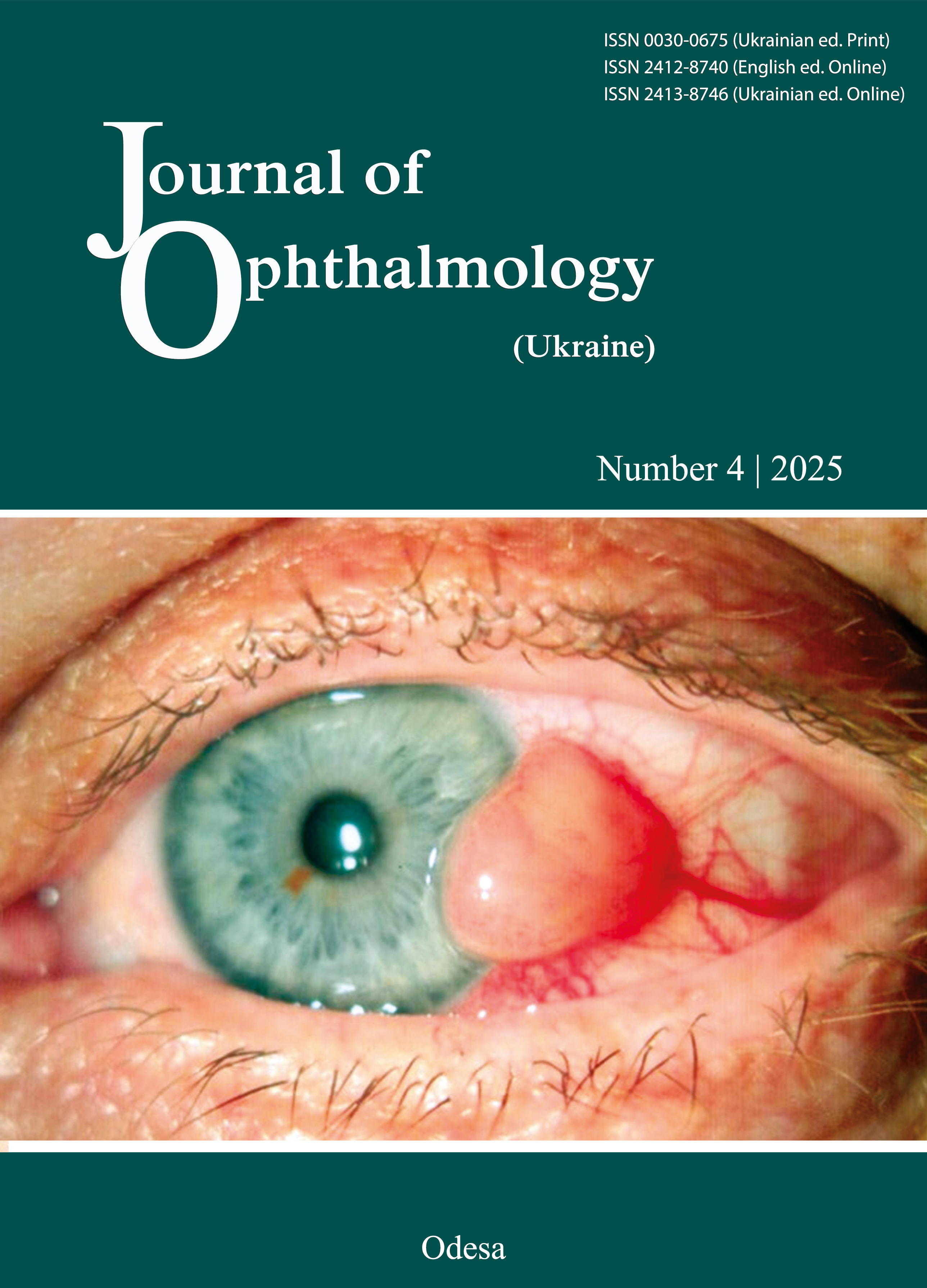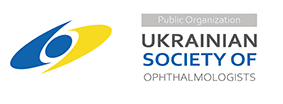Early postoperative visual impairments after surgery for tumors of the chiasmal and sellar region and the ways for correcting them
DOI:
https://doi.org/10.31288/oftalmolzh202544148Keywords:
tumors of the chiasmal and sellar region, compressive optic neuropathy, chiasmal blood supply, endoscopic endonasal surgery for tumors of the chiasmal region, local vasospasm, restorative treatmentAbstract
Purpose: to assess the frequency of visual function deterioration in the early postoperative period after the removal of tumors of the choroidal and sellar region (CSR), and develop effective treatment methods for postoperative local vasospasm.
Material and Methods. We retrospectively reviewed the medical records of 438 patients treated for compressive optic neuropathy due to tumors of the CSR at the Department for Endonasal Cranial Base Endosurgery, SI “Romodanov Neurosurgery Institute, National Academy of Medical Sciences of Ukraine”, in 2018-2024. The main group (group 1) was formed of 33 patients (66 eyes) with postoperative visual deterioration to assess the proposed strategy of treatment for postoperative local vasospasm. The retrospective control group (group 2) was used for comparison and comprised 34 patients (68 eyes) with a similar deterioration who underwent tumor surgery in 2014-2018 and did not receive the restorative treatment. Patients underwent clinical neurological and ophthalmological examinations and neuroimaging and functional studies.
Results. We analyzed the outcomes of treatment for postoperative vasospasm which included hemodilution, calcium channel blockers and peripheral vasolidators. In group 1, at day 1 and month 1 after surgery, the mean visual acuity (VA) was 0.44 ± 0.05 and 0.59 ± 0.04, respectively, and the mean mean deviation (MD), -15.34 ± 0.77 dB and -11.51 ± 0.79 dB, respectively (p < 0.05). In group 2, the mean VA improved from 0.38 ± 0.05 to 0.43 ± 0.04, and the mean MD improved from -15.46 ± 0.73 dB to -13.68 ± 0.69 dB, at month 1 compared to day 1 after surgery (p > 0.05). In group 1 and group 2, the mean VA was 0.44 ± 0.05 and 0.38 ± 0.04, respectively, at day 1 after surgery (p > 0.05), and 0.59 ± 0.04 and 0.43 ± 0.04, respectively, at month 1 after surgery (p < 0.05). Additionally, the mean MD was -15.34 ± 0.77 dB and 15.46 ± 0.73 dB, respectively, at day 1 after surgery (p > 0.05), and -11.51 ± 0.79 dB and -13.68 ± 0.69 dB, respectively at month 1 after surgery (p < 0.05).
Conclusion. With the proposed therapeutic treatment, VA improved from 0.44 ± 0.05 at day 1 after surgery to 0.59 ± 0.04 at one month after surgery, whereas MD improved from -15.34 ± 0.77 dB to -11.51 ± 0.79 dB (р < 0.05).
References
Bresson D, Herman P, Polivka M, Froelich S. Sellar Lesions/Pathology. Otolaryngol Clin North Am. 2016 Feb;49(1):63-93. https://doi.org/10.1016/j.otc.2015.09.004
Gotecha S, Kotecha M, Punia P, Chugh A, Shetty V. Neuro-Ophthalmic Manifestations of Intracranial Space Occupying Lesions in Adults. Beyoglu Eye J. 2022 Nov 15;7(4):304-312. https://doi.org/10.14744/bej.2022.50469
Tagoe NN, Essuman VA, Fordjuor G, Akpalu J, Bankah P, Ndanu T. Neuro-Ophthalmic and Clinical Characteristics of Brain Tumours in a Tertiary Hospital in Ghana. Ghana Med J. 2015 Sep;49(3):181-6. https://doi.org/10.4314/gmj.v49i3.9
Schmalisch K, Milian M, Schimitzek T, Lagrèze WA, Honegger J. Predictors for visual dysfunction in nonfunctioning pituitary adenomas - implications for neurosurgical management. Clin Endocrinol (Oxf). 2012 Nov;77(5):728-34. https://doi.org/10.1111/j.1365-2265.2012.04457.x
Nuijts MA, Veldhuis N, Stegeman I, van Santen HM, Porro GL, Imhof SM, et al. Visual functions in children with craniopharyngioma at diagnosis: A systematic review. PLoS One. 2020 Oct 1;15(10):e0240016. https://doi.org/10.1371/journal.pone.0240016
Agosti E, Alexander AY, Leonel LCPC, Van Gompel JJ, Link MJ, Pinheiro-Neto CD, et al. Anatomical Step-by-Step Dissection of Complex Skull Base Approaches for Trainees: Surgical Anatomy of the Endoscopic Endonasal Approach to the Sellar and Parasellar Regions. J Neurol Surg B Skull Base. 2022 Aug 25;84(4):361-374. https://doi.org/10.1055/a-1869-7532
Al-Bader D, Hasan A, Behbehani R. Sellar masses: diagnosis and treatment. Front Ophthalmol (Lausanne). 2022 Nov 24;2:970580. https://doi.org/10.3389/fopht.2022.970580
Azab WA, Khan T, Alqunaee M, Al Bader A, Yousef W. Endoscopic Endonasal Surgery for Uncommon Pathologies of the Sellar and Parasellar Regions. Adv Tech Stand Neurosurg. 2023;48:139-205. https://doi.org/10.1007/978-3-031-36785-4_7
Rawanduzy CA, Couldwell WT. History, Current Techniques, and Future Prospects of Surgery to the Sellar and Parasellar Region. Cancers (Basel). 2023 May 24;15(11):2896. https://doi.org/10.3390/cancers15112896
Budnick HC, Tomlinson S, Savage J, Cohen-Gadol A. Symptomatic Cerebral Vasospasm After Transsphenoidal Tumor Resection: Two Case Reports and Systematic Literature Review. Cureus. 2020 May 17;12(5):e8171. https://doi.org/10.7759/cureus.8171
Gnanalingham KK, Bhattacharjee S, Pennington R, Ng J, Mendoza N. The time course of visual field recovery following transphenoidal surgery for pituitary adenomas: predictive factors for a good outcome. J Neurol Neurosurg Psychiatry. 2005 Mar;76(3):415-9.https://doi.org/10.1136/jnnp.2004.035576
Mortini P, Barzaghi R, Losa M, Boari N, Giovanelli M. Surgical treatment of giant pituitary adenomas: strategies and results in a series of 95 consecutive patients. Neurosurgery. 2007 Jun;60(6):993-1002; discussion 1003-4. https://doi.org/10.1227/01.NEU.0000255459.14764.BA
Schick U, Hassler W. Surgical management of tuberculum sellae meningiomas: involvement of the optic canal and visual outcome. J Neurol Neurosurg Psychiatry. 2005 Jul;76(7):977-83. https://doi.org/10.1136/jnnp.2004.039974
Engelhardt J, Namaki H, Mollier O, Monteil P, Penchet G, Cuny E, et al. Contralateral Transcranial Approach to Tuberculum Sellae Meningiomas: Long-Term Visual Outcomes and Recurrence Rates. World Neurosurg. 2018 Aug;116:e1066-e1074. https://doi.org/10.1016/j.wneu.2018.05.166
Li-Hua C, Ling C, Li-Xu L. Microsurgical management of tuberculum sellae meningiomas by the frontolateral approach: surgical technique and visual outcome. Clin Neurol Neurosurg. 2011 Jan;113(1):39-47. https://doi.org/10.1016/j.clineuro.2010.08.019
Kachhara R, Nigam P, Nair S. Tuberculum Sella Meningioma: Surgical Management and Results with Emphasis on Visual Outcome. J Neurosci Rural Pract. 2022 Jun 8;13(3):431-440.https://doi.org/10.1055/s-0042-1745817
Chowdhury T, Prabhakar H, Bithal PK, Schaller B, Dash HH. Immediate postoperative complications in transsphenoidal pituitary surgery: A prospective study. Saudi J Anaesth. 2014 Jul;8(3):335-41. https://doi.org/10.4103/1658-354X.136424
Dinsmore A, Compton C, Kline L, Bhatti MT. I'm stuffed; visual loss after trans-sphenoidal adenomectomy. Surv Ophthalmol. 2014 Jan-Feb;59(1):124-7. doi: 10.1016/j.survophthal.2013.03.008. Epub 2013 Aug 1. PMID: 23911151. https://doi.org/10.1016/j.survophthal.2013.03.008
Santarius T, Jian BJ, Englot D, McDermott MW. Delayed neurological deficit following resection of tuberculum sellae meningioma: report of two cases, one with permanent and one with reversible visual impairment. Acta Neurochir (Wien). 2014 Jun;156(6):1099-102. https://doi.org/10.1007/s00701-014-2046-4
Dandona L, Dandona R. Revision of visual impairment definitions in the International Statistical Classification of Diseases. BMC Med. 2006 Mar 16;4:7. https://doi.org/10.1186/1741-7015-4-7
de Divitiis E, Esposito F, Cappabianca P, Cavallo LM, de Divitiis O. Tuberculum sellae meningiomas: high route or low route? A series of 51 consecutive cases. Neurosurgery. 2008 Mar;62(3):556-63; discussion 556-63. https://doi.org/10.1227/01.neu.0000317303.93460.24
Dicpinigaitis AJ, Feldstein E, Shapiro SD, Kamal H, Bauerschmidt A, Rosenberg J, et al. Cerebral vasospasm following arteriovenous malformation rupture: a population-based cross-sectional study. Neurosurg Focus. 2022 Jul;53(1):E15. https://doi.org/10.3171/2022.4.FOCUS2277
Bejjani GK, Sekhar LN, Yost AM, Bank WO, Wright DC. Vasospasm after cranial base tumor resection: pathogenesis, diagnosis, and therapy. Surg Neurol. 1999 Dec;52(6):577-83; discussion 583-4. https://doi.org/10.1016/S0090-3019(99)00108-1
Eseonu CI, ReFaey K, Geocadin RG, Quinones-Hinojosa A. Postoperative Cerebral Vasospasm Following Transsphenoidal Pituitary Adenoma Surgery. World Neurosurg. 2016 Aug;92:7-14. https://doi.org/10.1016/j.wneu.2016.04.099
Bergland R. The arterial supply of the human optic chiasm. J Neurosurg. 1969 Sep;31(3):327-34.https://doi.org/10.3171/jns.1969.31.3.0327
Gibo H, Lenkey C, Rhoton AL Jr. Microsurgical anatomy of the supraclinoid portion of the internal carotid artery. J Neurosurg. 1981 Oct;55(4):560-74. https://doi.org/10.3171/jns.1981.55.4.0560
Downloads
Published
How to Cite
Issue
Section
License
Copyright (c) 2025 Iegorova K. S., Guk M. O., Globa M. V., Musulevska V. V., Ukrainets O.V.

This work is licensed under a Creative Commons Attribution 4.0 International License.
This work is licensed under a Creative Commons Attribution 4.0 International (CC BY 4.0) that allows users to read, download, copy, distribute, print, search, or link to the full texts of the articles, or use them for any other lawful purpose, without asking prior permission from the publisher or the author as long as they cite the source.
COPYRIGHT NOTICE
Authors who publish in this journal agree to the following terms:
- Authors hold copyright immediately after publication of their works and retain publishing rights without any restrictions.
- The copyright commencement date complies the publication date of the issue, where the article is included in.
DEPOSIT POLICY
- Authors are permitted and encouraged to post their work online (e.g., in institutional repositories or on their website) during the editorial process, as it can lead to productive exchanges, as well as earlier and greater citation of published work.
- Authors are able to enter into separate, additional contractual arrangements for the non-exclusive distribution of the journal's published version of the work with an acknowledgement of its initial publication in this journal.
- Post-print (post-refereeing manuscript version) and publisher's PDF-version self-archiving is allowed.
- Archiving the pre-print (pre-refereeing manuscript version) not allowed.












